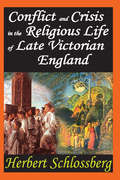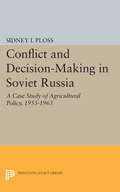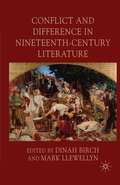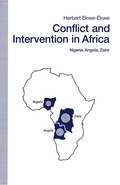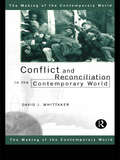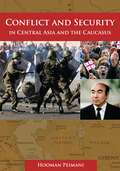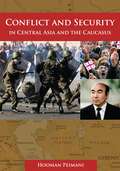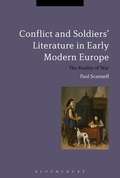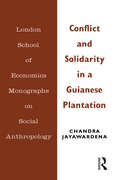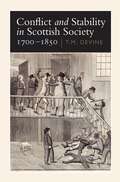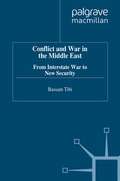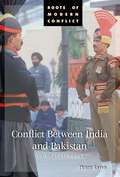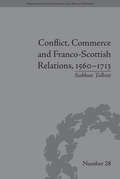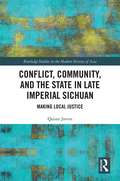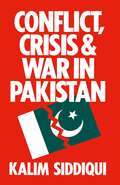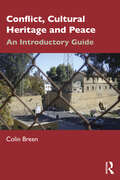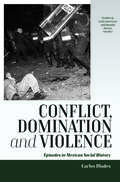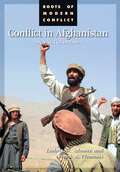- Table View
- List View
Conflict and Crisis in the Religious Life of Late Victorian England
by Herbert SchlossbergContrary to its popular image as dull and stodgy, the Victorian period was one of revolutionary change. In its politics, its art, its economic aff airs, its class relationships, and in its religion, change was constant. A half-century after Queen Victoria's death, it was said that she was born in one world and died in another. Th e most interesting and valuable studies of the period take the long view, as does Schlossberg, in his fascinating analysis of religious life in this period. For the Victorians, religion was not cordoned off from the push and shove of real life. Th e early evangelicals got off to a shaky start, beset by hostility, but the movement spread within the churches despite the suspicion in which it was held. Evangelicals, frequently called Puritans by those who opposed them, called for fundamental reforms in both the Church and the society; a social ethic was part of their program of religious renewal. Th eir moral sense explains the social activism of both Church of England Evangelicals and Dissenters, including the half-century crusade for the abolition of slavery. Schlossberg shows how religion in England dealt with such issues as science and the eff ect of German scholarship on religious thinking. Church history cannot simply be explained by its response to external forces as much as by the internal responses to those challenges. Th e nature of the religious enterprise itself, its theologians, clergy, lay people--like all people and all institutions--all responded with alternatives. Schlossberg helps us understand the Victorian period, as well as the increasing secularity of English life today.
Conflict and Crisis in the Religious Life of Late Victorian England
by Herbert SchlossbergContrary to its popular image as dull and stodgy, the Victorian period was one of revolutionary change. In its politics, its art, its economic aff airs, its class relationships, and in its religion, change was constant. A half-century after Queen Victoria's death, it was said that she was born in one world and died in another. Th e most interesting and valuable studies of the period take the long view, as does Schlossberg, in his fascinating analysis of religious life in this period. For the Victorians, religion was not cordoned off from the push and shove of real life. Th e early evangelicals got off to a shaky start, beset by hostility, but the movement spread within the churches despite the suspicion in which it was held. Evangelicals, frequently called Puritans by those who opposed them, called for fundamental reforms in both the Church and the society; a social ethic was part of their program of religious renewal. Th eir moral sense explains the social activism of both Church of England Evangelicals and Dissenters, including the half-century crusade for the abolition of slavery. Schlossberg shows how religion in England dealt with such issues as science and the eff ect of German scholarship on religious thinking. Church history cannot simply be explained by its response to external forces as much as by the internal responses to those challenges. Th e nature of the religious enterprise itself, its theologians, clergy, lay people--like all people and all institutions--all responded with alternatives. Schlossberg helps us understand the Victorian period, as well as the increasing secularity of English life today.
Conflict and Decision-Making in Soviet Russia: A Case Study of Agricultural Policy, 1953-1963 (PDF)
by Sidney I. PlossThis discussion of agricultural policy in the decade after Stalin shows how decisions are made and then enforced.Originally published in 1965.The Princeton Legacy Library uses the latest print-on-demand technology to again make available previously out-of-print books from the distinguished backlist of Princeton University Press. These editions preserve the original texts of these important books while presenting them in durable paperback and hardcover editions. The goal of the Princeton Legacy Library is to vastly increase access to the rich scholarly heritage found in the thousands of books published by Princeton University Press since its founding in 1905.
Conflict and Difference in Nineteenth-Century Literature
by D. Birch M. LlewellynHow should we understand Victorian conflict? The Victorians were divided between multiple views of the political, religious and social issues that motivated their changing aspirations. Such debates are a fundamental aspect of the literature of the period and these essays propose new ways of understanding their significance.
Conflict And Intervention In Africa: Nigeria Angola Zaire (pdf)
by G. Holderness J. Turner Nick PotterConflict and Reconciliation in the Contemporary World (The Making of the Contemporary World)
by David J. WhittakerConflict and Reconciliation in the Contemporary World gives a concise, original and multi-faceted introduction to the study of modern conflict situations. Using eight case- studies, from four continents: Yugoslavia, Israel, Northern Ireland, South Africa, El Salvador, Cambodia, Cyprus and Afghanistan, it includes discussion on: * threatened regional peace and security * cycles of internal discord, population displacement and violence * controversy over causes, progress and resolution * the value of external mediation, enforcement or intervention such as sanctions or "punishments" * means, timing and permanence of reconciliation.
Conflict and Reconciliation in the Contemporary World (The Making of the Contemporary World)
by David J. WhittakerConflict and Reconciliation in the Contemporary World gives a concise, original and multi-faceted introduction to the study of modern conflict situations. Using eight case- studies, from four continents: Yugoslavia, Israel, Northern Ireland, South Africa, El Salvador, Cambodia, Cyprus and Afghanistan, it includes discussion on: * threatened regional peace and security * cycles of internal discord, population displacement and violence * controversy over causes, progress and resolution * the value of external mediation, enforcement or intervention such as sanctions or "punishments" * means, timing and permanence of reconciliation.
Conflict and Security in Central Asia and the Caucasus
by Hooman PeimaniThis is the only book since the fall of the Soviet Union to analyze the security of the newly emerged independent states in the strategically vital region of Central Asia and the Caucasus.This insightful work maps out the possibilities and dangers that lie ahead for the nations of Central Asia and the Caucasus. The book analyzes the current security situation and clarifies its historical context, identifying the factors that have shaped the security of these young nations since their independence. It also examines the parameters—political, economic, ethnic, energy, and military—that will decide the security of the region in the future.The book's author tells the whole story behind the headlines when he discusses, for example, the real reason for the "wine war" of 2006, when Russia banned imports of Georgian wine for "health reasons," or when explaining the impact of the expanding American presence—both political and military—after September 11. Conflict and Security in Central Asia and the Caucasus is a primer for those who want to know more about this strategic region and essential reading for all students of world affairs.
Conflict and Security in Central Asia and the Caucasus
by Hooman PeimaniThis is the only book since the fall of the Soviet Union to analyze the security of the newly emerged independent states in the strategically vital region of Central Asia and the Caucasus.This insightful work maps out the possibilities and dangers that lie ahead for the nations of Central Asia and the Caucasus. The book analyzes the current security situation and clarifies its historical context, identifying the factors that have shaped the security of these young nations since their independence. It also examines the parameters—political, economic, ethnic, energy, and military—that will decide the security of the region in the future.The book's author tells the whole story behind the headlines when he discusses, for example, the real reason for the "wine war" of 2006, when Russia banned imports of Georgian wine for "health reasons," or when explaining the impact of the expanding American presence—both political and military—after September 11. Conflict and Security in Central Asia and the Caucasus is a primer for those who want to know more about this strategic region and essential reading for all students of world affairs.
Conflict and Soldiers' Literature in Early Modern Europe: The Reality of War (Bloomsbury Studies in Military History)
by Paul ScannellIn Conflict and Soldiers' Literature in Early Modern Europe, Paul Scannell analyses the late 16th-century and early 17th-century literature of warfare through the published works of English, Welsh and Scottish soldiers. The book explores the dramatic increase in printed material on many aspects of warfare; the diversity of authors, the adaptation of existing writing traditions and the growing public interest in military affairs.There is an extensive discussion on the categorisation of soldiers, which argues that soldiers' works are under-used evidence of the developing professionalism among military leaders at various levels. Through analysis of autobiographical material, the thought process behind an individual's engagement with an army is investigated, shedding light on the relevance of significant personal factors such as religious belief and the concept of loyalty. The narratives of soldiers reveal the finer details of their experience, an enquiry that greatly assists in understanding the formidable difficulties that were faced by individuals charged with both administering an army and confronting an enemy.This book provides a reassessment of early modern warfare by viewing it from the perspective of those who experienced it directly. Paul Scannell highlights how various types of soldier viewed their commitment to war, while also considering the impact of published early modern material on domestic military capability - the 'art of war'.
Conflict and Soldiers' Literature in Early Modern Europe: The Reality of War (Bloomsbury Studies in Military History)
by Paul ScannellIn Conflict and Soldiers' Literature in Early Modern Europe, Paul Scannell analyses the late 16th-century and early 17th-century literature of warfare through the published works of English, Welsh and Scottish soldiers. The book explores the dramatic increase in printed material on many aspects of warfare; the diversity of authors, the adaptation of existing writing traditions and the growing public interest in military affairs.There is an extensive discussion on the categorisation of soldiers, which argues that soldiers' works are under-used evidence of the developing professionalism among military leaders at various levels. Through analysis of autobiographical material, the thought process behind an individual's engagement with an army is investigated, shedding light on the relevance of significant personal factors such as religious belief and the concept of loyalty. The narratives of soldiers reveal the finer details of their experience, an enquiry that greatly assists in understanding the formidable difficulties that were faced by individuals charged with both administering an army and confronting an enemy.This book provides a reassessment of early modern warfare by viewing it from the perspective of those who experienced it directly. Paul Scannell highlights how various types of soldier viewed their commitment to war, while also considering the impact of published early modern material on domestic military capability - the 'art of war'.
Conflict and Solidarity in a Guianese Plantation (LSE Monographs on Social Anthropology)
by Chandra JayawardenaThis study concerns two communities of sugar plantation labourers, the descendants of indentured immigrants from India, who live in the county of Berbice, British Guiana. The study is focused on the analysis of social conflict: the factors that cause it, the forms it takes and its social consequences.
Conflict and Solidarity in a Guianese Plantation (LSE Monographs on Social Anthropology #Vol. 25)
by Chandra JayawardenaThis study concerns two communities of sugar plantation labourers, the descendants of indentured immigrants from India, who live in the county of Berbice, British Guiana. The study is focused on the analysis of social conflict: the factors that cause it, the forms it takes and its social consequences.
Conflict and Stability in Scottish Society 1700–1850
by T M DevineBetween the early eighteenth and the middle decades of the nineteenth century, Scottish society was transformed by industrialisation, urbanisation and major changes in agriculture and rural society. The rate of town and city growth was among the fastest in western Europe, migration and emigration accelerated and the traditional way of life in the Highland and Lowland countryside was brought to an end through the pressures of market demand and landlord strategy. Such a major upheaval created increased social tension.Conflict and Stabilitiy in Scottish Society challenges the previously accepted view that this major upheaval in Scottish life did not stimulate much unrest and that a modern industrial society developed relatively smoothly. The papers here, given at the Scottish Historical Studies Seminar at Strathclyde University in 1988–89, suggest that protest was more common, more enduring and more diverse than is usually supposed.
Conflict and War in the Middle East: From Interstate War to New Security
by Bassam TibiFew studies of Middle East wars go beyond a narrative of events and most tend to impose on this subject the rigid scheme of superpower competition. The Gulf War of 1991, however, challenges this view of the Middle East as an extension of the global conflict. The failure of the accord of both superpowers to avoid war even once regional superpower competition in the Middle East had ceased must give rise to the question: Do regional conflicts have their own dynamic? Working from this assumption, the book examines local-regional constraints of Middle East conflict and how, through escalation and the involvement of extra-regional powers, such conflicts acquire an international dimension. The theory of a regional subsystem is employed as a framework for conceptualising this interplay between regional and international factors in Tibi's examination of the Middle East wars in the period 1967-91. Tibi also provides an outlook into the future of conflict in the Middle East in the aftermath of the most recent Gulf War.
Conflict Between India and Pakistan: An Encyclopedia (Roots of Modern Conflict)
by Peter LyonThis up-to-date encyclopedia examines the conflict between India and Pakistan from Independence to the present day, with an authoritative treatment that presents the issues evenhandedly and from both countries' perspectives.Tensions between India and Pakistan are deeply rooted. Many go back to 1947 or earlier, when, with the partitioning of the provinces of Punjab and Bengal, British India was succeeded by two independent countries: a primarily Hindu India and a Muslim Pakistan. Subsequently, the two countries have fought three wars and come close to open war several other times, especially over Kashmir.Conflict Between India and Pakistan begins with a discussion of the partition of India and those who figured prominently in it, notably: Mohammed Ali Jinnah, Clem Attlee, the last viceroy, Admiral Louis Mountbatten, and Jawaharlal Nehru. Then, in a series of evenhanded, carefully crafted portraits, it describes the people, political parties, foreign and domestic policies, and economic, religious, and cultural pressures that have played a role in the conflicts between these nations from 1947 to the present.
Conflict, Commerce and Franco-Scottish Relations, 1560–1713 (Perspectives in Economic and Social History)
by Siobhan TalbottUsing untapped archival sources from Britain, France and America, Talbott presents a comparative view of British relations with France over the long seventeenth century.
Conflict, Commerce and Franco-Scottish Relations, 1560–1713 (Perspectives in Economic and Social History #28)
by Siobhan TalbottUsing untapped archival sources from Britain, France and America, Talbott presents a comparative view of British relations with France over the long seventeenth century.
Conflict, Community, and the State in Late Imperial Sichuan: Making Local Justice (Routledge Studies in the Modern History of Asia)
by Quinn JaversExploring local practices of dispute resolution and laying bare the routine role of violence in the late-Qing dynasty, Conflict, Community, and the State in Late Imperial Sichuan demonstrates the significance of everyday violence in ordering, disciplining, and building communities. The book examines over 350 legal cases that comprise the "cases of unnatural death" archival file from 1890 to 1900 in Ba County, Sichuan province. The archive presents an untidy array of death, including homicides, suicides, and found bodies. An analysis of the muddled and often petty disputes found in these records reveals the existence of a local system of authority that disciplined and maintained daily life. Often relying on violence, this local justice system occasionally intersected with the state’s justice system, but was not dependent on it. This study demonstrates the importance of informal, local authority to our understanding of justice in the late Qing era. Providing a non-elite perspective on Qing power, law, justice, and the role of the state, this book will be of great interest to students and scholars of Chinese and Asian history, as well as legal history and comparative studies of violence.
Conflict, Community, and the State in Late Imperial Sichuan: Making Local Justice (Routledge Studies in the Modern History of Asia)
by Quinn JaversExploring local practices of dispute resolution and laying bare the routine role of violence in the late-Qing dynasty, Conflict, Community, and the State in Late Imperial Sichuan demonstrates the significance of everyday violence in ordering, disciplining, and building communities. The book examines over 350 legal cases that comprise the "cases of unnatural death" archival file from 1890 to 1900 in Ba County, Sichuan province. The archive presents an untidy array of death, including homicides, suicides, and found bodies. An analysis of the muddled and often petty disputes found in these records reveals the existence of a local system of authority that disciplined and maintained daily life. Often relying on violence, this local justice system occasionally intersected with the state’s justice system, but was not dependent on it. This study demonstrates the importance of informal, local authority to our understanding of justice in the late Qing era. Providing a non-elite perspective on Qing power, law, justice, and the role of the state, this book will be of great interest to students and scholars of Chinese and Asian history, as well as legal history and comparative studies of violence.
Conflict, Cultural Heritage and Peace: An Introductory Guide
by Colin BreenConflict, Cultural Heritage and Peace offers a series of conceptual and applied frameworks to help understand the role cultural heritage plays within conflict and the potential it has to contribute to positive peacebuilding and sustainable development in post-conflict societies. Designed as a resource guide, this general volume introduces the multiple roles cultural heritage plays through the conflict cycle from its onset, subsequent escalation and through to resolution and recovery. In its broadest sense, it questions what role cultural heritage plays within conflict, how cultural heritage is used in the construction and justification of conflict narratives, how are these narratives framed and often manipulated to support particular perspectives, and how we can develop better understandings of cultural heritage and work towards the better protection of cultural heritage resources during conflict. It moves beyond the protection paradigm and recognises that cultural heritage can contribute to building peace and reconciliation in post-conflict environments. The study offers a conceptual and operational framework to understand the roles cultural heritage plays within conflict cycles, how it can be targeted during war, and the potential cultural heritage has in positive peacebuilding across the conflict lifecycle. Conflict, Cultural Heritage, and Peace offers an invaluable introduction to cultural heritage at all stages in conflict scenarios which will benefit students, researchers and practitioners in the field of heritage, environment, peace and conflict studies.
Conflict, Cultural Heritage and Peace: An Introductory Guide
by Colin BreenConflict, Cultural Heritage and Peace offers a series of conceptual and applied frameworks to help understand the role cultural heritage plays within conflict and the potential it has to contribute to positive peacebuilding and sustainable development in post-conflict societies. Designed as a resource guide, this general volume introduces the multiple roles cultural heritage plays through the conflict cycle from its onset, subsequent escalation and through to resolution and recovery. In its broadest sense, it questions what role cultural heritage plays within conflict, how cultural heritage is used in the construction and justification of conflict narratives, how are these narratives framed and often manipulated to support particular perspectives, and how we can develop better understandings of cultural heritage and work towards the better protection of cultural heritage resources during conflict. It moves beyond the protection paradigm and recognises that cultural heritage can contribute to building peace and reconciliation in post-conflict environments. The study offers a conceptual and operational framework to understand the roles cultural heritage plays within conflict cycles, how it can be targeted during war, and the potential cultural heritage has in positive peacebuilding across the conflict lifecycle. Conflict, Cultural Heritage, and Peace offers an invaluable introduction to cultural heritage at all stages in conflict scenarios which will benefit students, researchers and practitioners in the field of heritage, environment, peace and conflict studies.
Conflict, Domination, and Violence: Episodes in Mexican Social History (Studies in Latin American and Spanish History #2)
by Carlos IlladesConflict, domination, violence—in this wide-ranging, briskly narrated volume from acclaimed Mexican historian Carlos Illades, these three phenomena register the pulse of a diverse, but inequitable and discriminatory, social order. Drawing on rich and varied historical sources, Illades guides the reader through seven signal episodes in Mexican social history, from rebellions under Porfirio Díaz’s dictatorship to the cycles of violence that have plagued the country’s deep south to the recent emergence of neo-anarchist movements. Taken together, they comprise a mosaic history of power and resistance, with artisans, rural communities, revolutionaries, students, and ordinary people confronting the forces of domination and transforming Mexican society.
Conflict in Afghanistan: An Encyclopedia (Roots of Modern Conflict)
by Frank A. Clements Ludwig W. AdamecA comprehensive A–Z study of the history of conflict in Afghanistan from 1747 to the present.This authoritative, clearly written volume covers all aspects of the conflicts that have taken place in Afghanistan from 1747 to the present. Conflict in Afghanistan provides the reader with a historical overview of hostilities in Afghanistan and discusses their causes, history, and impact on Afghan society and on regional and international relations.A single A–Z section covers the three main eras in Afghanistan's history: the period from 1747, when Afghanistan first emerged as a "unified" state; the Soviet era (1979–1989), which saw the overthrow of the monarchy, the declaration of the Republic, and the rise of the Mujahideen; and the post-Soviet period, which brought civil war, the rise of the Taliban, and finally the events of September 11 and the War on Terrorism, both of which receive special attention.
